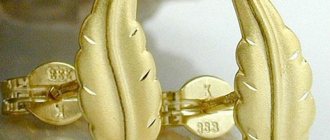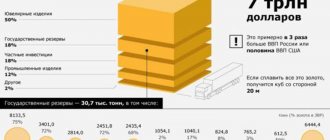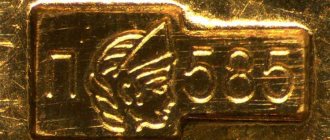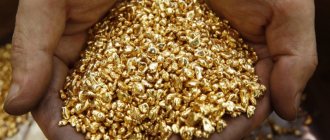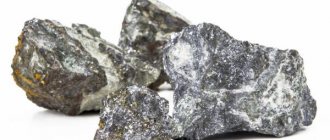Good afternoon We know a lot about the American gold rush - the unorganized mining of the precious metal by prospectors, mostly poor adventurers. Writers (Jack London, Jules Verne) and Hollywood cinema contributed to the mythologization of the gold rush in the United States. Stories about the tragic fate of the indigenous population of America - the Indians - played a role.
Gold deposits in Russia are also numerous. We have not been spared by the general obsession with wealth. The Russian gold rush lasted from the beginning of the 19th century and covered Siberia and the Far East - at that time remote, undeveloped territories.
There was a legend about Yegor, nicknamed Lesnoy, a former convict who was one of the first to begin independent mining in the Berikul River basin, but never reported where exactly he could find gold.
Where does gold come from?
Metals with an atomic mass of more than 55 units (heavier than iron), which cannot be formed inside stars, arise as a result of gamma-ray bursts - releases of energy in space during supernova explosions. Gold came to Earth with asteroids many years ago, when our planet was just being formed and had no atmosphere. Most of the heavy elements sank below the Earth's surface and formed the core.
There are few precious metals on the surface. Their main volume is located in the mantle - the substance between the earth's crust and core. In the upper layers of the mantle, a hot melt is formed - magma, which in some places penetrates the surface of the Earth. There it hardens and turns into solid rock, containing almost the entire periodic table.
Magma is heterogeneous, hardens unevenly - refractory substances coexist with low-melting substances, and the latter continue to circulate inside the solidified former. This is how gold veins are formed within the rock.
Where to look for and pan for gold
Noble metal carried by water flow is called alluvial metal. Such gold breaks off from the bedrock under the influence of gravitational forces, weathering and chemical attack. Placers of precious metal are terraced, bottom and spit.
The first signs of the presence of a deposit are often found along river banks. A water stream with a strong current gradually cuts deeper and deeper into the surface of the earth, forming terraces at the upper level. Large deposits of terraced gold can be found not only near existing rivers, but also in places where streams have long since dried up.
Bottom deposits are formed as a result of the seepage of metal particles through dense layers of rock to the bedrock bed. Experts recommend looking for gold where the bedrock is shallow. On the river bank, mining from placers located on sand or pebble spits can bring success.
The noble metal does not always reach the bedrock. It can become stuck in dense clay if the current is not strong enough to wash it away. Gold is heavier than clay, but it cannot penetrate through several layers of well-compacted material. In this case, the precious metal must be looked for close to the surface of such false bedrock.
Particles of yellow metal move only where the flow speed is high. In mountain streams and rivulets you can try your luck near large boulders, where natural traps form. In these places, the current slows down sharply and the golden sand sinks to the bottom. Such “pockets” most often form in front of and directly behind large boulders. A more attractive trap is the one downstream, where the gold is purer.
The most interesting areas to search are places where the strength of the flow decreases. At bends in the riverbed, gold in rivers moves under the influence of centrifugal forces. On the outside of the stream the flow is faster than on the inside. Accordingly, the sandbars and spits at the beginning of the inside turn are good places to explore.
The flow moves most powerfully during the spring flood. At the same time, the channel expands and changes its boundaries. It is useful to measure its width and calculate the core of the river, taking into account its bends. Metal particles always follow the shortest path. When the river returns to its original state, searches should be conducted along the calculated trajectory.
The speed of the flow slows down sharply at the point where the tributary flows into a lake or other river. Accordingly, the zone of potential gold deposition will be the beginning of the mouth. You can start your search in the area where the river exits the mountains onto the plain. The optimal place is the area where a stormy stream flows into a river.
Of interest to gold miners are waterfalls, under which a whirlpool and a pit form. This is a kind of natural filter for gold sand and nuggets. First of all, you should pay attention to the area where the flow exits the pool. Sometimes gold can be found right where the water falls. It is also recommended to examine the boulders.
Gold is 19 times heavier than water. It does not float, but drags along the bottom of the river. Therefore, it is necessary to look for the noble metal where barriers are erected in the path of the flow. Cracks and caverns, boulders, fallen tree trunks, shallows, spits, ledges and irregularities, holes and whirlpools are the main places for prospectors to explore.
Yellow metal satellites
The list of minerals that coexist with gold is quite long. Silver is most often found together with the noble metal. Other satellites: platinum, quartz, adularia, galena, pyrite, lead. The combination of these elements with gold can be very different.
However, the presence of these minerals does not always indicate the presence of yellow metal. But if a nugget is found, it always contains silver. Its share can range from a few tenths of a percent to significant amounts. The optimal ratio of the two precious metals is found in volcanic rock.
Necessary tool
Prospectors use special equipment to identify gold. The most traditional device is a metal detector, which allows you to probe the soil to a depth of 15 cm to 1 m. The main problem is its excessive sensitivity. The device is not tuned to yellow metal, i.e. the signal from iron and gold will be the same.
Today, more advanced special instruments have been developed that make it possible to search for nuggets at a depth of up to 1 m. This gold probe is equipped with a probe with a sensor device. A signal about the presence of a precious metal is given by direct contact with it. Unlike a metal detector, this equipment is not sensitive to soil type.
Searching with a metal detector
To search for gold in the ground and river beds, you must correctly set the sensitivity of the metal detector. The number of false signals that the device gives depends on it. It is also necessary to configure the ground balance function. This parameter will have to be adjusted every few minutes, since the composition of the soil is constantly changing.
When working with a metal detector, the coil should be kept as close to the ground as possible. When a signal is received, it is recommended to “listen” to the soil in all directions. If the sound fades quickly, then the signal is false. A similar check is carried out by lifting the coil up.
Classification of gold deposits
There are two types of deposits. They are divided into:
- primary, they are also radical;
- secondary - alluvial.
Indigenous
Primary deposits are the same fragments of magma ejected onto the surface of the globe. It happens that gold is present in the rock in the form of veins and nuggets, but more often it is alloyed with other elements: gold ores with copper, quartz, iron and sulfur compounds, and polymetallic alloys are common.
The main deposits of gold mined in Russia are concentrated in primary deposits.
Alluvial
Secondary deposits appeared as a result of destruction (weathering) of primary ones. Weathering refers to the impact not only of air currents, but also of water, temperature changes and even the activity of bacteria. It was alluvial deposits that were so diligently developed by amateur, lone miners.
Until the end of the 19th century, gold was mined mainly from placers - by washing (sliding), which is possible due to the relative gravity of gold. Lighter impurities were washed away with water, leaving gold sand in the washing trays, which was melted into ingots and products.
At the end of the 19th century - during the era of the birth of the scientific and technological revolution - technologies appeared that made it possible to effectively develop igneous rock. This has affected the scale of gold mining: it is believed that 60% of all gold mined in the entire history of mankind is metal produced over the past 150 years.
Gold mining map
In this article I will consider only a few regions of Russia - keep in mind, there are many more, especially in the Far East, Far North and Siberia.
Deposits of the European part of the Russian Federation
The largest amount of gold was deposited in areas where magma often reached the land surface - now there are mountains and hills, like in the Urals and Magadan. Therefore, in Central Russia there is almost no search for gold.
There are some placer deposits in the Kostroma region, on the Chabra and Chashchevaya rivers, but they are unlikely to be of interest to large gold mining companies. However, this is not a hindrance for amateur enthusiasts: if you want to try to wash a couple of grams of precious metal in the river, know that this is possible.
West of the Ural Range there are only three industrial gold mining provinces:
- Dnieper-Donetsk zone;
- Karelo-Kola;
- Caucasian.
The gold mining potential of these zones is the smallest of all those located in Russia.
Deposits of the Urals and Trans-Urals
The Ural gold mining province is fourth in the Russian ranking. It is inferior to the Baikal-Vitim, Altai-Sayan and Verkhoyansk-Kolyma provinces. The development of deposits in the Urals began in the 18th century, and by the end of the 20th century there were already more than 300 mines operating here.
The gold mining industry is most interested in primary deposits, but in the Urals and the West Siberian Plain there are many placers - mainly alluvial, that is, accumulated in river beds, “alluvial deposits”. The largest of them are located in the Perm, Chelyabinsk and Sverdlovsk regions.
Deposits of Eastern Siberia
Eastern Siberia is a region of Russia rich in precious deposits. Transbaikalia has been developed since the middle of the 19th century. The largest center of gold mining has always been the Irkutsk region: the village of Bolshie Koty, modern deposits with the picturesque names Sukhoi Log and Chertovo Koryto.
Single miners were content with working in the stream with a shovel and a tray, while organized groups dug orts - underground tunnels that were eventually connected into a network. In such a mine, workers (often convicts) heated the rock from morning to night.
It was dangerous to be in the orts: despite the fortifications, tunnels and passages kept collapsing, burying people under them. No one knows how many of these mass graves have survived - the comrades of the victims erected an impromptu monument and left, refusing to develop the deadly mine.
Gold mines of the Urals
The mines of the Urals, which are located on the eastern and western slopes, occupy a special place among all regions of Russia with developed gold mining. And this is quite logical. Here is the most suitable climate for this, the longest thermal period, and the absence of permafrost layers. The geographical location closer to the European part makes infrastructure and communications more developed. Any type of transport is available here, allowing for supplies, as well as making it easier for workers to live.
Working in the gold mines
These mines are the oldest in Russia. The beginning of gold mining here is considered to be 1745, although even before that the population found and mined this metal. At the beginning of the 20th century, mining was already carried out at 300 mines. The largest number of gold mining companies operate in the regions of Chelyabinsk and Sverdlovsk. Here gold is contained not only in placer and primary deposits, but is also part of complex ore deposits.
The most famous deposits
Sukhoi Log
Sukhoi Log is a deposit in the Lensky gold mining district (Irkutsk region). In its depths there are 2,500 tons of gold and 1,500 tons of silver (according to rough estimates). The concentration of pure precious metal in the ore is low; there are sections of the rock with a gold content of less than 1 g/t. The geological and industrial type of Sukhoi Log is a gold sulfide deposit, that is, the predominant impurities in the rock are sulfur compounds, mainly pyrite (iron pyrite). The average gold content in the ore is 2.7 g/t.
Sukhoi Log was opened in 1961 and is still being developed. Its reserves account for 15–28% (according to various sources) of all deposits in Russia.
Berezovskoe
The Berezovskoye deposit is a gold-sulfide-quartz deposit. It is located in the Sverdlovsk region (Middle Urals) and is considered one of the first discovered in Russia, standing at the origins of our gold mining. In 1748, the village of Berezovsky arose near the mine - now a satellite city of Yekaterinburg. The Berezovskoye field is being developed underground.
Vorontsovskoe
The Vorontsovskoye deposit (Middle Urals, 12 km from Krasnoturinsk) was discovered in 1985 by geologists and has a gold-arsenic-sulfide technological type. It is developed using an open-pit method - people and machines extract ore from a quarry.
Natalka
Natalka is located 390 km from Magadan, in the Tenkinsky district of the region. This is a gold-quartz deposit, the second largest resource in Russia after Sukhoi Log. The average gold content in the ore is 1.7 g/t.
The Natalka gold deposit was also discovered by geologists in the 1940s. It bears the name of Natalya, the daughter of D.T. Aseev, who discovered a gold-bearing stream at the site of future mining.
Which deposit is the largest?
The largest gold deposit in Russia is the above-mentioned Sukhoi Log. It has not yet been fully developed and has long been considered unpromising due to the fact that mining is complicated by the uneven, sometimes low, gold content of the ore. People have yet to master it.
How and where gold deposits can be developed
In many countries of the world (Australia, Finland, some US states), the government solved the problem of private mining simply - it resolved it. All you have to do is buy a license and you’re welcome to the stream with your tray. Citizens are allowed to use what they have obtained at their own discretion.
It's different in Russia. It is almost impossible to become legalized as a gold miner, Art. 191 of the Criminal Code of the Russian Federation is in effect, and the found metal must be handed over to the state. The bill on civil liberties and the issuance of licenses has been considered in the State Duma since 2009, but has not yet been adopted.
A single miner should focus on the map of alluvial deposits, of which there are many in the Urals and Transbaikalia. There are abandoned mines, the residual deposits of which are of no interest to industrial developers. You can find gold in river basins:
- Sanarka;
- Lena;
- Bodaibo;
- Big Chanchik;
- Bom;
- Talga et al.
Also see below how gold is mined by a prospector:
How to wash - manual extraction technologies
To determine the presence of gold in rock, prospectors use traditional iron or plastic trays. It is preferable to use a plastic tool: it is lightweight and does not leave fingerprints. The optimal tray diameter is 20-40 cm. Additionally, a sieve with a cell size of 12 cm is purchased.
A sure sign of the presence of gold deposits is if at least one grain gets into the sieve. A negative result does not mean the absence of precious metal: you need to try again. Beginners still use pans to pan for gold, while experienced miners use mini-drags.
This device helps to significantly increase labor productivity. In terms of operation, it resembles a vacuum cleaner. Rock is pumped into the injector from the bottom of the river, which then enters a special chute. There, gold is separated from other solid elements by washing. Minidrags differ significantly in power and performance. Large devices are capable of processing a ton of material per hour.

